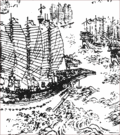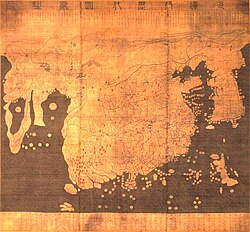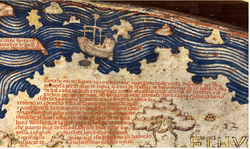Zheng He
- This is a Chinese name; the family name is Zheng.
Zheng He or Ma He is en (Chinese 郑和; 1371–1433) was an explorer, diplomat, and admiral from China. He lived during the Ming Dynasty. Zheng He was the leader of a very large fleet of ships that traveled all over the Indian Ocean and Southwest Asia. Zheng He was an eunuch of China's Imperial Court. The fleet that Zheng He commanded had 317 ships that were very large. 28,000 Chinese soldiers were on board these ships.
Early life
Zheng He was born in Kunyang, a village in Yunnan.[1] He was born with the name Ma He (Chinese 马三宝). He and his family were Muslim.[2] At the time, Yunnan was ruled by Mongols. In 1381, however, a Ming army invaded and took control of the area.[3]
Ma He was taken as a prisoner by the Ming armies. He was about 10 years old.[1] He was castrated and then taken away to serve the Prince, Zhu Di (the future emperor).[4] Ma He became a servant at the Imperial Court. The name Zheng He was given to him by the Prince. He also came to be called "Sanbao", a reference to the Three Jewels of Buddhism.[3]
Journeys
From 1405 to 1433, Zheng He went on seven journeys to the Indian Ocean, or what the Chinese people called the "Western Ocean". He was the leader of a large fleet of ships and a big army.
In his first three journeys he visited the countries of Southeast Asia, India and Sri Lanka. In his fourth to seventh journeys he went as far as the east African coast. In his journeys he gave the countries he visited gifts of silk, porcelain, gunpowder and other goods. He got lots of unusual gifts as well, including giraffes and zebras.
Zheng He had his first journey from 1405–1407, but it is not known why the journey was made. He travelled from the mouth of the Yangtze River to Vietnam, as well as the south of India. His fleet was made up of 317 ships, more than 27,000 men, and the cargo included porcelain, silk, and lacquerware. He used a treasure fleet which is known as the largest wooden ships ever built, being 400 feet (120 m) long, and about 150 feet (46 m) wide. On his first voyage, he defeated a famous pirate in the Strait of Malacca.
For the next 28 years, Zheng He traveled on six more voyages. From 1407–1409, he visited Calicut, Thailand and Java. From 1409–1411, he saw Ayutthaya, Malaya, Sumatra and Sri Lanka. From 1413–1415, he went to Sri Lanka, Bengal, India, Hormuz, Arabia and Aden. On his fifth journey, from 1417–1419, he visited the Ryukyu Islands, Brunei, and east Africa. Then from 1421–1422, he expanded on his fifth journey. His final journey, from 1433–1435, he revisited many of the previous places and brought back gifts from many rulers.
Zheng He visited over 30 countries, and is believed to have died in 1433 on the journey home during the final treasure fleet voyage. After Zheng He died at sea in 1433, his treasure fleet quickly faded, even though his voyages had been a success. Less than 100 years after his death, all of the ships from China were destroyed.[4]
Zheng He Media
Early 17th-century Chinese woodblock print, thought to represent Zheng He's ships
The Kangnido map (1402) predates Zheng's voyages and suggests that he had quite detailed geographical information on much of East Asia and moderate information on the rest of the Old World.
Detail of the Fra Mauro map relating the travels of a junk into the Atlantic Ocean in 1420. The ship also is illustrated above the text.
One of a set of maps of Zheng He's missions (郑和航海图), also known as the Mao Kun map, 1628
Galle Trilingual Inscription, left by Zheng He in Sri Lanka in 1409
The pet giraffe of the Sultan of Bengal, brought from the Somali Ajuran Empire, and later taken to China in the thirteenth year of Yongle (1415).
Notes
- ↑ 1.0 1.1 Louise Levathes (1996). When China Ruled the Seas: The Treasure Fleet of the Dragon Throne, 1405–1433. Oxford University Press. p. 58–61. ISBN 0-19-511207-5.
- ↑ J. V. G. Mills (1970). Ying-yai Sheng-lan, The Overall Survey of the Ocean's Shores (1433), translated from the Chinese text edited by Feng Ch'eng Chun with introduction, notes and appendices by J. V. G. Mills. White Lotus Press. p. 5. ISBN 974-8496-78-3.
- ↑ 3.0 3.1 Edward L. Dreyer (2007). Zheng He: China and the Oceans in the Early Ming, 1405–1433. Longman. p. 12. ISBN 978-0-321-08443-9.
- ↑ 4.0 4.1 Tsai, Shih-shan Henry. "Zheng He." World Book Student. World Book, 2013. 4 December 2013.
References
- "Zheng He Maritime Expeditions (Overview)." World History: Ancient and Medieval Eras. ABC-CLIO, 2013. Web. 4 Dec. 2013.
- "Voyages of Zheng He." World History: Ancient and Medieval Eras. ABC-CLIO, 2013. Web. 4 Dec. 2013.
- "Cheng Ho." Explorers & Discoverers of the World. Gale, 1993. Biography in Context. Web. 4 Dec. 2013.
Other websites
 Media related to Zheng He at Wikimedia Commons
Media related to Zheng He at Wikimedia Commons- Ancient History Encyclopedia - The Seven Voyages of Zheng He
- TIME magazine special feature on Zheng He (August 2001) Archived 2001-09-13 at the Wayback Machine










